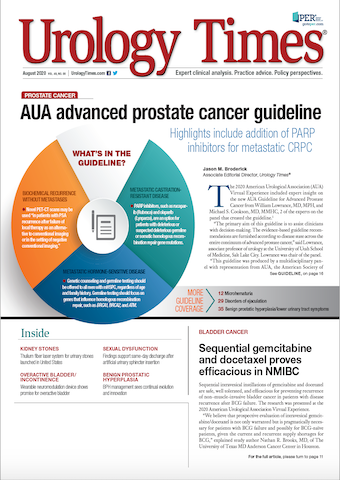Publication
Article
Urology Times Journal
Panel expert details changes to AUA BPH guideline
Author(s):
Steven A. Kaplan, MD, explains the updates in the AUA 2020 guideline on lower urinary tract symptoms secondary to benign prostatic hyperplasia.
During the 2020 AUA Virtual Experience, Steven A. Kaplan, MD, explained the changes incorporated into the 2020 AUA Guideline on Benign Prostatic Hyperplasia (BPH): Surgical Management of BPH/Lower Urinary Tract Symptoms (LUTS).1
“This guideline [on LUTS secondary to BPH] should be used in conjunction with recent systematic literature reviews and an understanding of the patient’s treatment goals. In all cases, the patient’s preferences and personal goals should be considered when choosing therapy,” said Kaplan, a member of the AUA BPH Surgical Panel responsible for the guideline, and a professor of urology at the Icahn School of Medicine.
Overall, the guideline comprises 24 statements divided into 15 categories. The broader categories are Evaluation and Preoperative Testing, Surgical Therapy, and Medically Complicated Patients.
The treatment-specific categories are Transurethral Resection of the Prostate (TURP); Simple Prostatectomy; Transurethral Incision of the Prostate (TUIP); Transurethral Vaporization of the Prostate (TUVP); Photoselective Vaporization of the Prostate (PVP); Prostatic Urethral Lift (PUL); Transurethral Microwave Therapy (TUMT); Water Vapor Thermal Therapy; Transurethral Needle Ablation (TUNA); Laser enucleation; Aquablation; and Prostate Artery Embolization (PAE).
AUA guidelines use a 3-tiered evidence system in which the evidence level associated with a statement is classified as high (A), moderate (B), or low (C), and that recommendations without a sufficient evidence basis are labeled as a clinical principle or expert opinion.
In his presentation, Kaplan detailed the 2020 updates, which included 1 new statement and several amended statements.
New Statement
The new statement, known as “statement 6,” was added to the “Evaluation and Preoperative Testing” section of the guideline. The statement, which is categorized as a clinical principle, reads:
“Clinicians should inform patients of the possibility of treatment failure and the need for additional or secondary treatments when considering surgical and minimally-invasive treatments for LUTS secondary to BPH.”
The text for this statement was taken from supporting text on retreatment and treatment failure from the treatment modality statements.
Regarding this new statement, Kaplan said, “The text for this statement was taken from the corresponding treatment modality statements.” Some of the statements that were amended to have retreatment and/or treatment failure information moved to statement 6 included statement 15 on PUL, statement 17 on TUMT, statement 18 on water vapor thermal therapy, and statement 22 on aquablation.
Amended Statements
The first amendment was made to statement 1, which is part of the “Evaluation and Preoperative Testing” section of the guidelines. The statement now recommends that a physical examination, along with a medical history, should be conducted as part of the initial assessment of patients with “bothersome” LUTS potentially caused by BPH (clinical principle). The AUA Symptom Index should be used, and the physician should perform a urinalysis.
Additionally, supporting text added to the statement reads, “When focusing on the results of the urinalysis, clinicians should focus on the presence or absence of glucosuria, proteinuria, hematuria, and infection.”
The wording of statement 16 on PUL (grade C) was amended to now read, “PUL may be offered to eligible patients who desire preservation of erectile and ejaculatory function.”
Although the wording of statement 19 on water vapor thermal therapy (grade C) was not changed, the supportive text was amended based on the latest literature.
The statement itself reads, “Water vapor thermal therapy may be offered to eligible patients who desire preservation of erectile and ejaculatory function.”
The new supporting text states:
“In the randomized controlled trial comparing water vapor thermal therapy to sham, the original 136 patients randomized to water vapor thermal therapy are expected to be followed for 5 years. Few harms occurred in the water vapor thermal therapy group between months 3 and 12.
A decrease in ejaculatory volume was reported by 2% of participants. At 36 months, no de novo erectile dysfunction was reported but dysuria was reported by 1% of patients. At 48 months, there was a significant change in International Index of Erectile Function (IIEF) scores compared to baseline with a P value of .3. But there was not a significant change at the other follow-up intervals.”2
Supporting text was also updated based on new literature for statement 21 on laser enucleation (grade B), and the statement itself was also changed. Specifically, the word “suitable” was removed before the word options, so it now reads:
“Clinicians should consider holmium laser enucleation of the prostate (HoLEP) or thulium laser enucleation of the prostate (ThuLEP), depending on their expertise with either technique, as prostate size-independent options for the treatment of LUTS attributed to BPH.”
The wording of statement 23 on PAE (expert opinion) was also amended and now reads:
“PAE for the treatment of LUTS secondary to BPH is not supported by current data and trial designs, and benefit over risk remains unclear; therefore, PAE is not recommended outside the context of clinical trials.”
Looking Ahead
The AUA BPH panel is currently working on the guideline and algorithm for the medical management of BPH, which is slated to be released next year. The literature for this guideline was pulled from the date range of 2010 through 2019, with the evidence reported included 107 randomized controlled trials and controlled clinical trials.
“We will modify and evolve some of the statements from the 2020 BPH guideline and incorporate this into the 2021 guideline, and update [the information] based on the current literature. This will also include any updates in the surgical management of BPH, as well.”
The complete 2020 guideline is accessible on the AUA’s website.
References
1. Kaplan SA. AUA Guidelines 2020: BPH. Presented during 2020 AUA Virtual Experience. June 27-28, 2020.
2. McVary KT, Rogers T, Roehrborn CG, et al. Rezūm water vapor thermal therapy for lower urinary tract symptoms associated with benign prostatic hyperplasia: 4-year results from randomized controlled study. Urology. 2019;126:171-179. doi: 10.1016/j.urology.2018.12.041.




























